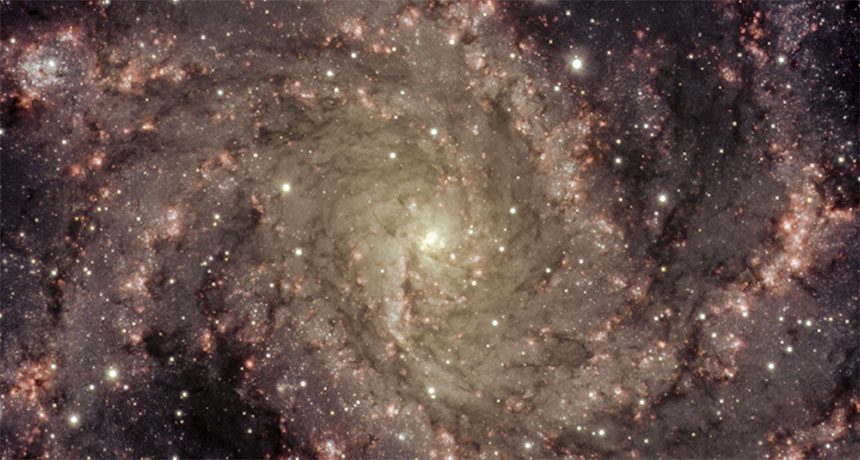
FIZZLED SIZZLE A star that vanished in galaxy NGC 6946 (pictured) might be the first confirmed case of a failed attempt at a supernova.
Gemini Observatory/AURA
- More than 2 years ago
A star that mysteriously disappeared might be the first confirmed case of a failed supernova, a star that tried to explode but couldn’t finish the job. A newborn black hole appears to have been left behind to snack on the star’s remains.
In 2009, a star in the galaxy NGC 6946 flared up over several months to become over 1 million times as bright as the sun. Then, it seemed to vanish. While the star could just be hiding behind a wall of dust, new observations with the Hubble Space Telescope, reported online September 6 at arXiv.org, strongly suggest that the star did not survive. A faint trickle of infrared light, however, emanates from where the star used to be. The remnant glow probably comes from debris falling onto a black hole that formed when the star died, write Caltech astronomer Scott Adams and colleagues.
Black holes are typically thought to form in the aftermath of a supernova, the explosive death of a massive star. But multiple lines of evidence have recently hinted that not all heavyweights go out with a bang. Some stars might skip the supernova and collapse into a black hole. Until now, though, evidence that this happens has been either spotty or indirect.
“This is the first really solid observational evidence for a failed supernova,” says Elizabeth Lovegrove, an astronomer at the University of California, Santa Cruz. “Some supernovas really do fail and this is what they look like.”
This attempt at a supernova, first observed with the Large Binocular Telescope in Arizona, occurred about 19 million light-years away in the constellation Cygnus. Only one other known star — a yellow supergiant that faded away in 2010 — is suspected to be a failed supernova, though there’s not enough data to say for certain.
When a star at least eight times as heavy as the sun runs out of thermonuclear fuel, it can no longer support its own weight. Gas crashes down on the star’s core, bounces and sends a shock wave racing back toward the surface that tears the star apart. Some stars might be so massive that the shock wave doesn’t have enough oomph to push against the onrush of collapsing star stuff. The shock fizzles, the supernova fails and the core gathers enough mass to collapse into a black hole, possibly taking the rest of the star down with it.
If the dying star is a red supergiant — a ruddy orb that can be over 1,000 times as wide as the sun — it might give a signal before vanishing. As the core collapses, it releases an enormous amount of gravitational energy. A second shock wave ripples up through the star — not powerful enough for an explosion, but enough to burp off the loosely held outer layers of the supergiant and expose the feeding black hole.
That’s exactly what Adams and colleagues think they saw. Hubble images from before 2009 reveal a star about 25 to 30 times as massive as the sun sitting where the flash of light came from. The star doesn’t show up in images taken since the eruption. Neither the brightness of the flash, the rate at which the brightness evolved nor the amount of light coming from there now fully matches other types of stellar incidents, such as a collision between a pair of stars or the violent outbursts that accompany some aging supermassive stars.
If the star did give birth to a black hole, X-rays may be radiating from debris spiraling down its gravitational throat. Adams and collaborators are waiting on observations from the space-based Chandra X-ray Observatory to check that idea. They also continue to monitor what’s left of the star. The star might still be there, hiding within a shell of dust expelled during the 2009 eruption. If that’s the case, it should become visible again in the coming years as the cloak dissipates.







